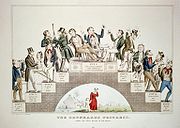
Methodist Board of Temperance, Prohibition, and Public Morals
Encyclopedia

Methodist Episcopal Church
The Methodist Episcopal Church, sometimes referred to as the M.E. Church, was a development of the first expression of Methodism in the United States. It officially began at the Baltimore Christmas Conference in 1784, with Francis Asbury and Thomas Coke as the first bishops. Through a series of...
Board of Temperance, Prohibition, and Public Morals was a major organization in the American
United States
The United States of America is a federal constitutional republic comprising fifty states and a federal district...
temperance movement
Temperance movement
A temperance movement is a social movement urging reduced use of alcoholic beverages. Temperance movements may criticize excessive alcohol use, promote complete abstinence , or pressure the government to enact anti-alcohol legislation or complete prohibition of alcohol.-Temperance movement by...
which led to the introduction of prohibition
Prohibition
Prohibition of alcohol, often referred to simply as prohibition, is the practice of prohibiting the manufacture, transportation, import, export, sale, and consumption of alcohol and alcoholic beverages. The term can also apply to the periods in the histories of the countries during which the...
in 1920. It was headed for many years by Clarence True Wilson.
The Methodist Episcopal Church South had a similar agency called the Board of Temperance and Social Service, with which Bishop James Cannon, Jr. was long associated.
The Board of Temperance, Prohibition and Public Morals constructed the Methodist Building on Capitol Hill in Washington, DC in the 1920's to further increase its influence and lobbying
Lobbying
Lobbying is the act of attempting to influence decisions made by officials in the government, most often legislators or members of regulatory agencies. Lobbying is done by various people or groups, from private-sector individuals or corporations, fellow legislators or government officials, or...
power in public policy matters regarding alcoholic beverage
Alcoholic beverage
An alcoholic beverage is a drink containing ethanol, commonly known as alcohol. Alcoholic beverages are divided into three general classes: beers, wines, and spirits. They are legally consumed in most countries, and over 100 countries have laws regulating their production, sale, and consumption...
s.
After ratification
Ratification
Ratification is a principal's approval of an act of its agent where the agent lacked authority to legally bind the principal. The term applies to private contract law, international treaties, and constitutionals in federations such as the United States and Canada.- Private law :In contract law, the...
of the Eighteenth Amendment
Eighteenth Amendment to the United States Constitution
The Eighteenth Amendment of the United States Constitution established Prohibition in the United States. The separate Volstead Act set down methods of enforcing the Eighteenth Amendment, and defined which "intoxicating liquors" were prohibited, and which were excluded from prohibition...
to the United States Constitution
United States Constitution
The Constitution of the United States is the supreme law of the United States of America. It is the framework for the organization of the United States government and for the relationship of the federal government with the states, citizens, and all people within the United States.The first three...
established Prohibition
Prohibition
Prohibition of alcohol, often referred to simply as prohibition, is the practice of prohibiting the manufacture, transportation, import, export, sale, and consumption of alcohol and alcoholic beverages. The term can also apply to the periods in the histories of the countries during which the...
, the Methodist Board promoted its aggressive enforcement. It also attempted to eliminate any criticism or opposition to what many called the Noble Experiment. In 1925, it charged that vaudeville
Vaudeville
Vaudeville was a theatrical genre of variety entertainment in the United States and Canada from the early 1880s until the early 1930s. Each performance was made up of a series of separate, unrelated acts grouped together on a common bill...
acts and comic strips were being used to dispense wet (anti-prohibition) propaganda
Propaganda
Propaganda is a form of communication that is aimed at influencing the attitude of a community toward some cause or position so as to benefit oneself or one's group....
in New York City, which it called “a foreign city, run by foreigners for foreigners according to foreign ideas.”
The Methodist Board was dissolved after a merger of Methodist denominations in the 1960s and the united church created the General Board of Church and Society (GBCS). The 1965 trust
Trust law
In common law legal systems, a trust is a relationship whereby property is held by one party for the benefit of another...
contract
Contract
A contract is an agreement entered into by two parties or more with the intention of creating a legal obligation, which may have elements in writing. Contracts can be made orally. The remedy for breach of contract can be "damages" or compensation of money. In equity, the remedy can be specific...
requires all principal and income from the trust’s assets to be used exclusively for “work in the areas of temperance and alcohol problems.”
Some United Methodists have pointed out that the GBCS corporation is funding programs on antiwar, environmental, technological, and dozens of other activities unrelated to reducing the consumption of alcohol. GBCS officials respond that they interpret the trust’s language to include a variety of social causes.
The GBCS has asked the D.C. Superior Court to ratify its interpretation of the 1965 trust edocument. A trial is scheduled in late 2008.
Sources
- Kyvig, David. Repealing National Prohibition. Chicago, IL: University of Chicago Press, 1979.
- Sali, Sean. Methodist building transfer delayed. Washington Times, May 6, 2004.
- Sann, Paul. Lawless Decade. NY: Bonanza, 1957.

